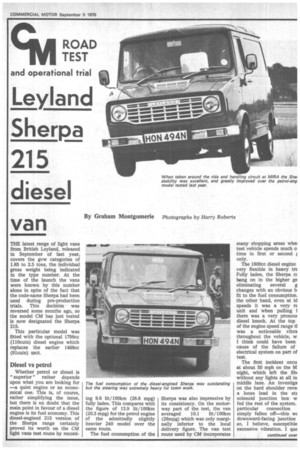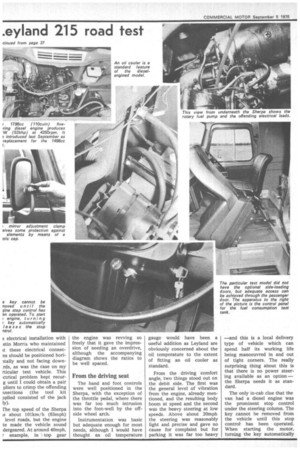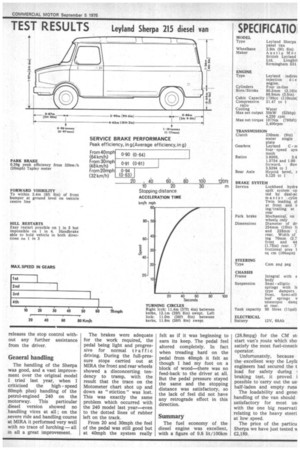Leyland Sherpa 215 diesel van
Page 39

Page 40

Page 41

If you've noticed an error in this article please click here to report it so we can fix it.
By Graham Montgomerie
Photographs by Harry Roberts THE latest range of light vans from British Leyland, released in September of last year, covers the gvw categories of 1.85 to 2.5 tons, the individual gross weight being indicated in the type number. At the time of the launch the vans were known by this number alone in spite of the fact that the code-name Sherpa had been used during pre-production trials. This decision was reversed some months ago, so the model CM has just tested is now designated the Sherpa 215.
This particular model was fitted with the optional 1798cc (11.0cuin) diesel engine which replaces the earlier 1498cc (91cuin) unit.
Diesel vs petrol
Whether petrol or diesel is " superior " rather depends upon what you are looking for —a quiet engine or an economical one. This is, of course, rather simplifying the issue, but there is no doubt that the main point in favour of a. diesel engine is its fuel economy. This diesel-engined 215 version of the Sherpa range certainly proved its worth on the CM light vans test route by record jag 9.8 lit/100km (28.8 mpg) fully laden. This compares with the figure of 13.9 lit/100km (20.3 mpg) for the petrol engine of the admittedly slightly heavier 240 model over the same route.
The fuel consumption of the Sherpa was also impressive by its consistency. On the motorway part of the test, the van averaged 10.1 lit/100km (28mpg) which was only marginally inferior to the local delivery figure. The van test route used by CM incorporates many shopping areas whe] test vehicle spends much 0. time in first or second only.
The 1800cc diesel engine very flexible in heavy trz Fully laden, the Sherpa cc hang on in the higher ge eliminating several g changes with an obvious 13, fit to the fuel consumption. the other hand, even at id speeds it was a very rz unit and when pulling I there was a very pronour diesel knock. At the top of the engine speed range ti was a noticeable vibra throughout the vehicle, w I think could have been cause of the failure of electrical system on part of test.
The first incident occu at about 50 mph on the M night, which left the Stu without any lights at all in middle lane. An investiga on the hard shoulder reve; a loose lead in the str solenoid junction box w fed the rest of the system. particular connection simply fallen off—this wf downward-facing junction so, I believe, susceptible excessive vibration. I que s electrical installation with stin Morris who maintained it these electrical connecns should be positioned horiltally and not facing down.rds, as was the case on my rticular test vehicle. This ctrical problem kept recurg until I could obtain a pair pliers to crimp the offending rmections (the tool kit pplied consisted of the jack IY) rhe top speed of the Sherpa s about 101km/h (63mph) level roads, but the engine te made the vehicle sound dergeared. At around 40mph, 7 example, in top gear the engine was revving so freely that it gave the impression of needing an overdrive, although the accompanying diagram shows the ratios to be well spaced.
From the driving seat
The hand and foot controls were well positioned in the Sherpa, with the exception of the throttle pedal, where there was far too much intrusion into the foot-well by the offside wheel arch.
Instrumentation was basic but adequate enough for most needs, although I would have thought an oil temperature gauge would have been a useful addition as Leyland are obviously concerned about the oil temperature to the extent of fitting an oil cooler as standard.
From the driving comfort angle, two things stood out on the debit side. The first was the general level of vibration from the engine, already mentioned, and the resulting body boom at speed and the second was the heavy steering at low speeds. Above about 20mph the steering was reasonably light and precise and gave no cause for complaint but for parking it was far too heavy —and this is a local delivery type of vehicle which can spend half its working life being manoeuvred in and out of tight corners. The really surprising thing about this is that there is no power steering available as an option — the Sherpa needs it as standard.
The only in-cab clue that the van had a diesel engine was the prominent stop control under the steering column. The key cannot be removed from the vehicle until this stop control has been operated. When starting the motor, turning the key automatically releases the stop control without any further assistance from the driver.
Ge-neral handling The handling of the Sherpa was good, and a vast improvement over the original model I tried last year, when I criticised the high speed 60mph plus) handling of the petrol-engined 240 on the motorway. This particular diesel version showed no handling vices at all ; on the severe ride and handling course at MIRA it performed very well with no trace of lurching—all in all a great improvement. The brakes were adequate for the work required, the pedal being light and progressive for normal traffic driving. During the full-pressure stops carried out at MIRA the front and rear wheels showed a disconcerting tendency to tramp, with the result that the trace on the Motometer chart shot up and down as " stiction " was lost. This was exactly the same problem which occurred with the 240 model last year—even to the dotted lines of rubber left on the track.
From 20 and 30mph the feel of the pedal was still good but at 40mph the system really felt as if it was beginning to earn its keep. The pedal feel altered completely. In fact when treading hard on the pedal from 40mph it felt as though I had my foot on a block of wood—there was no feed-back to the driver at all. But the pedal pressure stayed the same and the stopping distance was satisfactory, so the lack of feel did not have any retrograde effect in this direction.
Summary
The fuel economy of the diesel engine was excellent, with a figure of 9.8 lit/100km (28.8mpg) for the CM st, start van's route which sho satisfy the most fuel-conscic operator.
Unfortunately, because the 'excellent way the Leylz engineers had secured the t load for safety during 1 braking test, it proved i possible to carry out the us' half-laden and empty runs The loadability and genei handling of the van should satisfactory for most us' with the one big reservati relating to the heavy steer at low speed.
The price of the particu Sherpa we have just tested IA £2,189.
























































































































